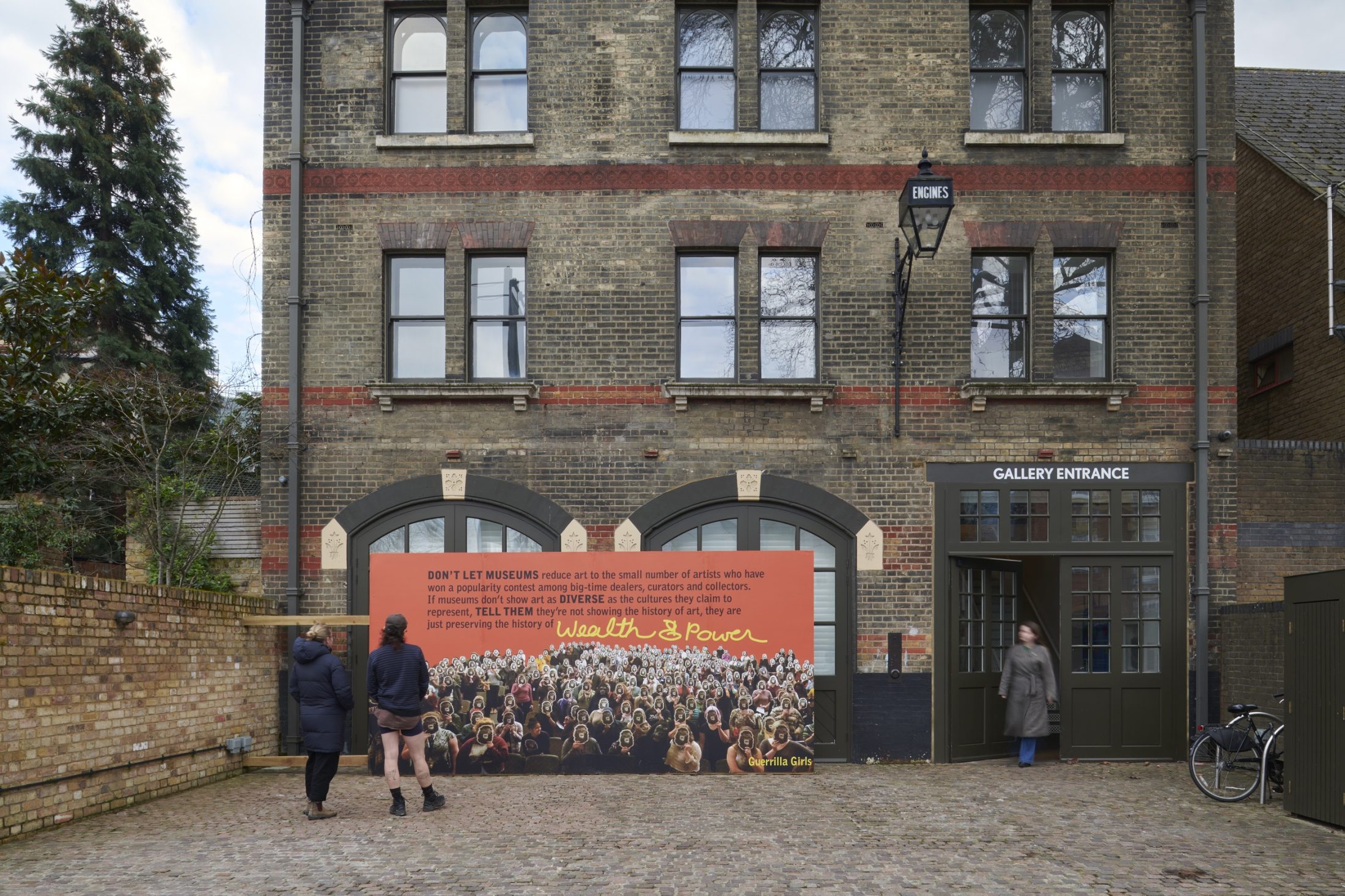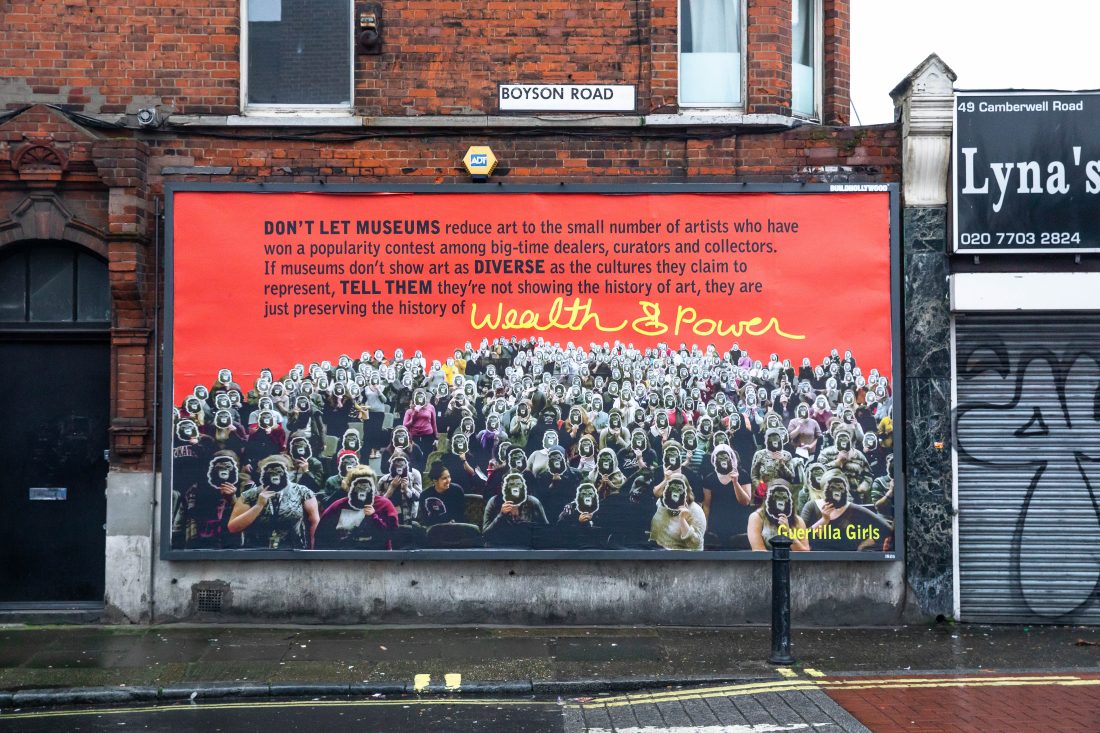
Installation Acts of Resistance: Photography, Feminisms and the Art of Protest, 2024. South London Gallery. Photo: Jo Underhill
Guerrilla Girls are a collective of anonymous artist activists, founded in New York in 1985. For decades the Guerrilla Girls’ activism has exposed sexism, corruption and racial inequality in the arts and beyond. Their artistic approach combines humour with statistics and bold graphic imagery on posters, banners, stickers and billboards. To remain anonymous, and to reference the idea of guerrilla tactics, members wear gorilla masks.
Once describing themselves as the “conscience of the art world”, their form of institutional critique is directed at museums, the commercial gallery system and universities. The collective also embraces art in the public realm to bring the issues they raise into a broader public consciousness.
As part of Acts of Resistance: Photography, Feminisms and the Art of Protest, their billboard, which critiques how museums acquire and display artwork, appears outside the Fire Station and on billboards across London, thanks to the support of BUILDHOLLYWOOD. Zara Afthab spoke to two members of the collective, who go by the aliases Frida Kahlo and Käthe Kollwitz. Read on to find out more about their activism, and head over to BUILDHOLLYWOOD for the full interview.
The Guerrilla Girls have been protesting against museums and resisting the structures inherent to art institutions for almost four decades; what prompted this form of protest?
Frida: It all kicked off in 1985 when the Museum of Modern Art reopened after a fancy renovation with a show titled the International Survey of Painting and Sculpture. The show featured 91% white male artists, and it struck us as ironic because they so clearly stated that it was an international survey, but how ‘international’ could a show like that be? Many artists like us were angry at the exhibit, so we decided to protest outside the museum. We formed a picket line and came with picket signs and chants, but it didn’t seem to have an effect on anyone. The people going in and out of the museum seemed upset at our presence, but it didn’t stop anyone from going in and they still didn’t really question what the museum was showing.
Käthe: We came to the conclusion that this form of the protest wasn’t working and pledged that day to try to find a better way to wake people up to examine the art world and criticise it just as other fields of human endeavour are critiqued. Our goal was centered around wanting to show how the system is not as open and fair as everyone wanted to think. We called a meeting with a bunch of people and started making these street posters where we would use crazy headlines and statistics to wake people up to how limiting museums and galleries really were.
The art world you critiqued in the 1980s is quite different from the one now, what was the immediate reaction to the posters?
Käthe: Initially there was a real divide between people who loved us and people who hated us. But in a way that was great because they created the dialogue and back and forth for us. As time went on, we think there are fewer and fewer people who disagree with us.
There’s this idea that objects in the museum have an inherent quality and value to them and so much of GG’s work deftly challenges that notion. Why was it important for your work to challenge ways of thinking and looking?
Frida: Our goal is to get people to think about things they haven’t thought about already because the more you deep dive into discrimination, it’s about all kinds of other things. It’s about the economy. It’s about history. It’s about all kinds of things that people might not be aware of. To be honest, art has not been critically looked at by the general public because there’s this crazy idea of art appreciation, which doesn’t really have a critical component to it. So people will go to museums that have European art, and they’ll see painting after painting of naked women being acted upon. Perhaps it’s through mythological and historical scenes. But they’re still looking at sexual violence, but no one really identifies it as such because there’s lots of beautiful flesh and there’s draperies in the sky and what not. So we’re trying to make people look closer at the content of art and how it reflects our culture. And it’s not to moralise them and say that those paintings are bad. It’s just that they are about what they’re about even if it is violent. When we complain about sexual violence and violence in our culture today, we have to look at the art of the past to see that it was always there in some form.
The question of tokenism is one that definitely comes up when artists from marginalised backgrounds get a single solo show or when their cultural identity eclipses their art. The backlash focuses on how art institutions and commercial galleries are riding a trend cycle with their curatorial efforts and programming. I wonder if you could shed some light on why major institutions are falling behind?
Käthe: I think we are making strides in the art world but it’s really hard to change these stultified places. They’re also stuck with their collections because they haven’t historically collected diverse artists with all kinds of backgrounds and points of view. On the other hand, so many curators today are trying to push that rock up a hill. If you look at a place like the Tate Modern and the exhibitions they put on you can see that shift immediately. But there’s still the problem of the permanent collection and the innate prejudice on how curators choose things. They also have to answer to the people at the top who want the work that they collect shown and they probably don’t collect the work of marginalised artists. So these issues go on and on and on. Luckily, you cannot stop artists from making art and that’s why we have a culture. It’s not dictated by curators or collectors who decided it was good art or bad art. Culture is created by artists who keep pressing on and doing things that none of us would ever expect.
Frida: There’s a kind of structural problem in the art world and that is that it is chiefly concerned with unique objects that can exist in only in one place at one time and that sort of plays into capitalism and the production of luxury items that can only be pursued by the super wealthy. Museums are expensive places to run and if you don’t have public funding then museum workers have to find art collectors in whose interests it is to have museums exhibit what they collect. It’s a tremendous conflict of interest that goes against all kinds of ideas about an ethical and free market.
Those concerns with the art market and museum culture relate to your work from 2016, History of Wealth and Power that is being shown on billboards across London. Could you tell us a bit more about the inspiration behind the work?
Käthe: It’s a foundational work of ours that succinctly states what we’ve been talking about throughout this conversation about structural problems in the museum. The statement, “don’t let museums show only the history of wealth and power”, is confronting and guides people into thinking about the works in art spaces more critically. It’s a simple poster with all our usual ingredients, a statement that’s conveyed in a way that’s unforgettable and a crazy visual of a huge audience of almost all women holding gorilla masks over their heads to grab people’s attention and it’s had an incredible effect around the world.
Frida: While making this work we were looking at at the history of European art, which we’re most familiar with, especially art made before the age of revolution and what we realised was that art before the 19th century was always what kings and queens and emperors told us it was. Naturally, one would have thought that the age of democracy would democratise the visual arts but in our age, it’s going backwards because it’s money that dictates art and billionaires have become the new aristocracy in terms of defining taste.

Image courtesy BUILDHOLLYWOOD
There has been this huge explosion of art that similar to the work done by the Guerrilla Girls, overtly confronts socio-political issues specifically those that relate to gender, capitalism and race. Major galleries and museums are now collecting and displaying this work such as the SLG, how does the intersection of resistance and art help the feminist cause?
Frida: Art has always taken on society and been about creating a dialogue, but the political art that is being created now speaks to how in contemporary times everyone is trying to step up and not accept the status quo. We’re on a precipice now with the rise of authoritarianism art and other human expression has to somehow be offended by that and go against what existed before.
Käthe: Seeing shows of art that takes on society is really interesting because they affirm to so many people, especially students, who are all trying to fight this screwed up system and make things better that their efforts are crucial and valued. What these shows do especially well is showing the historical context, the contemporary landscape, and inspire people to work towards the future.
It’s been almost 4 decades since the Guerrilla Girls was formed, we would love to know how the work being made and the way you work with art institutions has shifted?
Käthe: It feels really rewarding now when museums ask us to come in and do projects where we criticise their collections. There’s always this fear that their invite is a setup to being co-opted but in our experience we’ve always found that there’s a genuine desire to move past what existed before.
Frida: Organisations that feel the need to change but don’t quite know how to do it or they don’t know where to start reach out to us work on projects. We’ve been staging complaint departments all over the world now where we go in, paint a wall and invite people to come in and complain about anything they want. Then at the end of it we have the institution document the complaints and it becomes a time capsule of discontent at a certain time and in a certain place. It’s a very interesting, kind of journalistic experiment that’s great fun to do, because you never know what’s going to happen. We never really thought when we started that we would that we would be asked to come inside an institution and critique it and while we do still feel like outsiders, it’s great that we’re able to communicate with the public through these institutions.
Acts of Resistance: Photography, Feminisms and the Art of Protest is a collaborative exhibition between the SLG and the Victoria and Albert Museum, (V&A) as part of the V&A Parasol Foundation Women in Photography Project.
Free to visit and on display until 9 June 2024 across the South London Gallery’s two buildings.
Lead Exhibition Donor: The Bukhman Family Foundation
Exhibition Donors: Bagri Foundation, Action 4 Equality Scotland, Elizabeth Brooks, and the Exhibition Supporters’ Circle
Public Programme Funder: The Ampersand Foundation
The V&A Parasol Foundation Women in Photography Project is generously funded by Ms. Ruth Monicka Parasol and The Parasol Foundation Trust

Printing supported by: Beyond Print and Genesis Imaging
